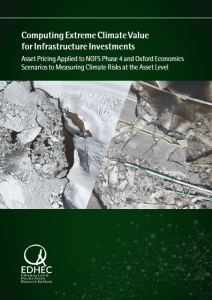

Computing Extreme Climate Value for Infrastructure Investments: Asset Pricing Applied to NGFS Phase 4 and Oxford Economics Scenarios to Measuring Climate Risks at the Asset Level
This paper describes the novel method that we have developed to measure climate risks. While we here apply this method to infrastructure assets, it paves the way to us ...
Author(s):
Summary:
This paper describes the novel method that we have developed to measure climate risks. While we here apply this method to infrastructure assets, it paves the way to using similar approaches to enlarge the scope of its application.
Summary
Investors in infrastructure assets are increasingly concerned by the risks posed by climate change. Indeed, extreme weather events can damage physical assets, leading to direct losses, increased maintenance costs, and lower asset values (e.g., the deadly flood in north-eastern Italy in May 2023). Such risks are referred to as physical risks. To mitigate climate change and its associated physical risks, various solutions are being designed, including climate policies and carbon taxes to encourage the shift toward greener technologies as well as changes in consumer preferences. However, such efforts will also come at a cost to companies, in particular those that rely heavily on non-renewable energy. Indeed, transitioning to greener technologies will represent a significant cost, one which many companies may find difficult to bear. Such risks are called transition risks.
There is thus no perfect solution to tackle the challenge of climate change: acting against climate change will entail transition costs, while not doing so will incur physical damage, the costs of which may exceed transition costs. In this context, understanding the impact of climate risks is critical when making informed decisions in infrastructure investment, and there is a growing need for a quantitative assessment of climate risks and their impact on infrastructure portfolios. However, this is a challenging task, as methods to quantify the consequences of climate change on infrastructure investments are still at an early development stage.
This paper specifically aims to tackle this issue, by describing the novel method that we have developed to measure climate risks. While we here apply this method to infrastructure assets, it paves the way to using similar approaches to enlarge the scope of its application.
Register to download PDF
Register/Log in| Type : | EDHEC Publication |
|---|---|
| Date : | 16/01/2024 |

